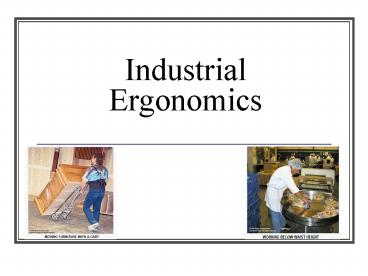Industrial Ergonomics - PowerPoint PPT Presentation
1 / 57
Title: Industrial Ergonomics
1
Industrial Ergonomics
2
Implement Solutions
Weve identified the problems, now what?
- Engineering Controls
- Administrative Controls
- PPE
3
Engineering Controls
- Preferred method of control
- Changes to equipment, tools, workstations,
controls and work flow that eliminate or
significantly reduce ergonomic risk factors
4
Engineering Controls
- Redesign workstations
- Redesign tools
- Modify workstation lighting
- Vibration control
- Noise control
- Automation
- Mechanical lifting device
- Material flow
5
Administrative controls
- Changes to task responsibilities that reduce
ergonomic risk factors - Changes implemented to reduce the duration,
frequency and severity of exposure to ergonomic
risk factors - Does not eliminate risk, it reduces risk
exposure
6
Administrative Controls
- Employee rotation
- Job task enlargement
- Adjustment of work pace
- Redesign of work methods
- Alternative tasks
- Rest Breaks
7
Work Practice Controls
- Changes to procedures or work methods, work
techniques procedures - Does not eliminate risk factors but may reduce
some contributing factors - Requires continuing and ongoing supervision
8
Work Practice Controls
- Work techniques and procedures
- Conditioning periods
- Training
- Personal protective equipment
9
Ergonomic Guidelines
10
Ergonomic Voluntary Guidelines
Industry Effective Date Meatpacking
Plants 1993 Furniture Manufacturing
Industry 2002 Telecommunications
Industry 2004 Nursing Homes 2003 Retail
Grocery Stores 2004 Poultry Processing 2004
Shipyard Industry In Process
11
Industry Risk for MSDs
- Nursing personal care facilities
- Home health services
- Hospitals
- Transportation and public utilities
- Construction
- Manufacturing
- Agriculture
- Finance, insurance, real estate
Source BLS, 2001
12
Job Tasks More Likely To Result In MSDs
- Meat processing
- Manufacturing
- Checkout scanning at a supermarket
- Keypunching
- Sewing knitting
- Activities of Butchers
- Surface Grinding
- Painting
- Activities of Dentists
- Assembly line work
13
Problems Solutions
The Ladder Dolly http//www.humantech.com
14
Problems Solutions
15
After
Before
16
(No Transcript)
17
Drum Handler
18
(No Transcript)
19
(No Transcript)
20
(No Transcript)
21
Standing Workstation Challenge - Before
Design Guidelines
22
Standing Workstation Dimensions
Design Guidelines
23
Standing Workstation Challenge - After
Design Guidelines
24
Material Handling Challenge - Before
Design Guidelines
25
Material Handling Dimensions
Design Guidelines
26
Material Handling Challenge - After
Design Guidelines
27
Horizontal Work Reach Challenge - Before
Design Guidelines
28
Horizontal Work Reach Dimensions
Design Guidelines
29
Horizontal Work Reach Challenge - After
Design Guidelines
30
Sitting Strength Challenge - Before
Design Guidelines
31
Sitting Strength
Design Guidelines
32
Sitting Strength - After
Design Guidelines
33
Tool Challenge - Before
Design Guidelines
34
Tool Dimensions
Design Guidelines
35
Tool Challenge - After
Design Guidelines
36
Manual Material Handling (MMH)
- CASE STUDY
37
(No Transcript)
38
(No Transcript)
39
(No Transcript)
40
(No Transcript)
41
(No Transcript)
42
(No Transcript)
43
(No Transcript)
44
(No Transcript)
45
(No Transcript)
46
(No Transcript)
47
TELL ME.
- WHAT WOULD YOU RECOMMEND??
- Find It Fix It
48
FINAL THOUGHTS..Cost Justification
49
Financial Benefits of HS Improvements
Cost Justification
- Ergonomics positive impact on health and safety
and the related costs. - Direct Costs
- Costs than can be tracked to a WMSD incident
- Direct medical costs
- Workers compensation payments
- Indirect Costs
- Costs that increase when WMSDs occur
- Time (nurses, supervisors) to manage and treat
WMSDs - Cost to recruit and train replacement workers
- Poor quality due to missing operator
50
Financial Benefits of HS Improvements
Cost Justification
- Although the direct and indirect costs can be
substantial, they do not fit well into typical
cost justification. - Why?
- Worker Comp savings is really cost Avoidance
- It is difficult to capture all of the dollars
spent on an injury - Justification often needs to show an immediate
impact on the bottom line - So
- We must consider another approach...
51
Financial Benefits of Performance Improvements
Cost Justification
- Ergonomics positive impact on production
performance and the related costs. - Quality
- Delivery
- Productivity
- These improvements have proven to be the most
straightforward means of cost justifying
ergonomic improvements. - These improvements are simple to predict and
quantify through the - Elimination of non-value-added tasks
- Reduction in motion waste
52
Value-Added
Cost Justification
- Value-added is anything that changes the shape or
character of the product so it is more valuable
to the customer. - Examples
- Joining parts A and B
- Cutting materials to size
- Sanding a part edge
53
Non-Value-Added
Cost Justification
- Non-value-added does not change the size or
character of the part or assembly and a customer
is not willing to pay more for your product. - Examples
- Conveying parts to an assembly line
- Carrying finished material to a pallet
- Rework
If it doesnt add value, its waste.
Henry Ford
54
Using Value-Added Analysis
Cost Justification
- Five steps can be used to perform a value-added
analysis. - Steps
- List the main tasks completed in an operation.
- Divide the tasks into task elements.
- Determine if each task element is value-added or
non-value-added. - Identify those non-value-added tasks and task
elements that also contribute to ergonomic risk
exposure. - Develop an improvement plan that focuses on the
non-value-added task elements that contribute to
ergonomic risk.
55
Applying Value-Added Analysis - Example
Cost Justification
56
Applying Value-Added Analysis - Example
Cost Justification
- Success
- Time Savings 3.2 seconds.
- Ergonomic risk is reduced in this operation.
57
Questions??
Thanks Everyone!! Have a Safe Drive Home!































